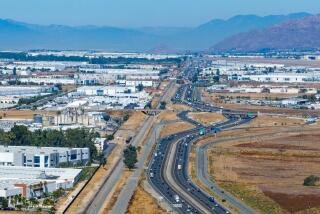Vote on Ojai Valley Area Plan Delayed : Land use: Rezoning of large tracts near Sulphur and Black mountains is a key issue. Supervisors will rule on the matter next month.
- Share via
Acknowledging the concerns of more than a dozen landowners, the Ventura County Board of Supervisors delayed a vote on an updated Ojai Valley Area Plan pending further study of the issue.
“Something of this importance that has taken this long to develop but still has so many questions could use a little more time,” said Supervisor Judy Mikels. “I’m not ready to vote on it.”
Supervisors and about 60 residents attending the meeting agreed that one issue in particular demands another look: the rezoning of large tracts of land around Sulphur and Black mountains on the south end of the valley. The board decided to close public debate on the plan but continue to study it before voting on it July 18.
The updated plan, which is expected to shape development in the 74,000-acre Ojai Valley for the next 10 to 15 years, restricts the subdivision of large tracts of land. Owners of large lots that can now be subdivided into 40-acre parcels would be restricted to subdividing their land into lots of 80 acres or larger.
Presently, subdividing land in the Ojai Valley is a moot point because of strict federal air quality standards and a county near-moratorium on new housing that affects traffic on badly congested California 33. But landowners still wanted their voices heard.
“It’s really redundant to adopt this plan because you can’t develop now anyway,” said land-use planner Charles Evans. “But many of these people feel their rights are being taken away nonetheless.”
Criticism from landowners centered around the economics of zoning.
“Forty acres is a big piece of land,” said Sherman Stacey, a Santa Monica attorney representing his client’s 400-acre parcel along Sulphur Mountain Road.
“I can’t see a compelling reason to raise the zoning to 80 acres,” Stacey said. “All it does is make development unfeasible. To bring in water, electricity and access roads for five parcels instead of 10 is too costly.”
Ted Bentley, whose family owns 994 acres off Creek Road, agreed that the rezoning would severely affect any plans he has for the property.
“It will deprive my family of the economic use of this property,” Bentley said. “At least with 40 acres I can get some clustering of homes. But who’s going to pay for two miles of sewer lines for just five lots? It’s like the county is condemning my property.”
The guiding thesis of the new Ojai Valley plan, which was first adopted in 1963 and last updated in 1979, is to curb growth.
“We want to greatly limit development in the Ojai Valley,” said Bill Prather, a member of the citizen board that guided the county’s 3 1/2-year effort to revamp the area plan. “We want to slow down the pace of development to preserve and protect the character of the Ojai and its airshed.”
Proponents maintain that limiting subdivisions on large tracts of undeveloped land to 80 acres would help ensure that valley growth is limited.
It’s a plan so intent on preserving the rural character of the valley that even the environmentally conscious city of Ojai has voiced its approval.
“It’s an outstanding plan that we support wholeheartedly,” said Ojai Councilman James D. Loebl. “We’d like to see the plan adopted without any changes.”
Among other environmental considerations in the plan are an expressed desire to limit California 33 to two lanes and the creation of a special zone protecting ridgelines from development.
Those proposals appealed greatly to the citizens committee and environmentalists.
“The people in the Ojai Valley aren’t pro-development,” said Stan Greene, president of Citizens to Preserve the Ojai. “We know that we can’t overuse our resources like air quality. It’s a very fragile environment.”
But the two proposals also met with criticism from Supervisor Mikels and landowners.
Mikels criticized the ridgeline program as too vague. And attorney Lindsay F. Nielson, who was representing three clients, called the highway policy irresponsible.
“Highway 33 shouldn’t be used as a planning tool to restrict development,” Nielson said. “Fixing it is an issue of public safety. It’s just not safe.”
More to Read
Sign up for Essential California
The most important California stories and recommendations in your inbox every morning.
You may occasionally receive promotional content from the Los Angeles Times.










